Product placement is one of the most effective ways for brands to integrate into entertainment content, reaching audiences organically while enhancing brand visibility. Whether appearing in films, television shows, web series, or even video games, the right placement can boost brand awareness, drive sales, and build long-term associations with pop culture.
However, negotiating a product placement deal requires careful planning and strategic execution. Brands must consider factors like audience alignment, contractual terms, and the level of integration before signing any agreement. Understanding how to approach and negotiate these deals ensures that brands receive maximum return on investment while maintaining creative and brand integrity.
Understanding the Value of Product Placement

Product placement is not just about getting a logo on screen, it’s about storytelling. A well-integrated placement feels natural within the narrative, enhancing both the brand and the content without feeling forced. Conversely, a poorly executed placement can be distracting or even damage the brand’s reputation.
The value of a placement depends on several factors, including the prominence of the product, the reputation of the content, and the size of the audience. A high-profile film with an A-list cast will demand a much higher fee than an independent film or a web series with a niche following. Some placements are simple visual appearances, while others involve characters actively using or endorsing the product, which can significantly impact pricing and negotiation strategies.
Identifying the Right Opportunities

Before entering negotiations, brands should carefully evaluate which content opportunities align with their target audience and marketing goals. A luxury brand may prioritize placements in high-end dramas or films set in affluent settings, while a tech company might seek placement in sci-fi productions.
Add your film to Garvescope’s film marketplace and get instant access to a global network of film investors, sponsors, and buyers.
Garvescope also offers world-class, personalized business and marketing services for filmmakers and indie film and TV projects. Learn more
Brands should consider:
| Audience demographics | Does the show’s or film’s audience align with the brand’s target market? |
| Tone and genre | Does the content align with the brand’s image and values? |
| Level of integration | Will the product be a background prop, used by a main character, or directly mentioned in dialogue? |
| Distribution potential | Will the content be widely distributed on major platforms, or is it limited to niche audiences? |
Understanding these factors before negotiations begin helps brands make informed decisions and strengthens their position at the bargaining table.
Crafting a Negotiation Strategy

Once a suitable opportunity has been identified, brands must enter negotiations with a clear strategy. Product placement deals can range from simple one-time fees to more complex arrangements involving revenue sharing, cross-promotion, or long-term partnerships.
Things to negotiate include:
| Placement Type | Will the product be passively placed in the background, actively used by a character, or featured as a plot element? Each level of integration carries a different cost |
| Exclusivity | Will competitors be allowed to appear in the same content, or will the brand receive category exclusivity? |
| Screen Time and Visibility | How long will the product be visible? Will it appear in close-up shots, or will it remain in the background? |
| Marketing and Promotion | Will the production team collaborate with the brand on co-marketing efforts, such as social media campaigns or tie-in advertisements? |
| Legal Rights | Who owns the rights to use footage of the placement in advertising campaigns? Ensuring the brand can leverage the placement in its own marketing efforts adds significant value. |
| Performance Metrics | Can the brand receive audience data, viewership statistics, or engagement metrics post-release? Some productions may be willing to provide analytics to demonstrate the placement’s impact. |
By clarifying these terms, brands can avoid misunderstandings and ensure they receive the level of exposure they expect.
Negotiating the Financial Terms

The cost of product placement varies widely based on factors like the production’s budget, the prominence of the placement, and the expected reach. Brands should be prepared to negotiate based on their marketing budget and the value of the placement.
Common pricing models:
| Flat Fees | A one-time payment for the placement, often used in films and scripted television. |
| Revenue Shares | Some content creators may offer a revenue-sharing model, where the brand pays a percentage of sales generated from the placement. |
| Barter Deals | Instead of paying in cash, brands provide free products, services, or sponsorships in exchange for placement. This is common in lower-budget productions. |
| Cross-Promotion Agreements | The brand promotes the content in exchange for placement, creating a mutually beneficial marketing strategy. |
Understanding industry norms and being flexible in negotiations can lead to better deals, especially when working with independent productions or digital content creators who may be open to alternative payment structures.
Ensuring Successful Execution

Once a deal is in place, successful execution is critical. Brands should maintain communication with the production team to ensure proper placement and avoid last-minute changes that could diminish the value of the deal.
To maximize results:
- Provide clear guidelines on how the brand should be represented while allowing for creative flexibility.
- Stay involved throughout production to ensure the product is placed as agreed.
- Coordinate with the production’s marketing team to amplify the placement through co-branded content, press releases, and social media campaigns.
- Measure results through viewership data, brand lift studies, and audience engagement metrics.
A well-executed product placement deal not only boosts brand awareness but can also lead to ongoing partnerships with production companies, creating more opportunities for future placements.
Negotiating for Maximum Impact
A successful product placement deal is about more than just getting a brand on screen, it’s about aligning with the right content, negotiating favorable terms, and ensuring the placement enhances both the brand and the story. By carefully selecting opportunities, defining clear expectations, and executing a strategic negotiation, brands can turn product placement into a powerful marketing tool that delivers long-term value.

Leave a Reply